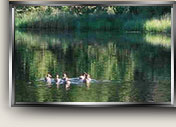Stewardship Plan Executive Summary
The Vandevert
Ranch Stewardship Plan for natural resources is written for the
owners of the ranch and their governing association. The plan addresses the
management of the common area woodlands, the riparian areas, the
meadow, and wildlife on the ranch. Private owner lots are addressed
in the CC&R’s. Roads, structures, fences, paddocks, the pasture,
the riding arena, and landscaped areas will be addressed in the
Operations section of the ranch web site (under Owners). Rainbow
Lake, being manmade, is also
addressed under Operations rather than in the stewardship plan.
This plan was
substantially updated in the spring of 2008 from the plan originally
developed by the ranch foreman in 2004. Further improvements
will continue to be integrated into the plan on the ranch web site.
The plan provides information and recommendations to the Vandevert
Ranch Association and has not been officially adopted by the
Association in whole or in part.
Purposes of
the Plan
1. To present the natural
resource mission and objectives of the Vandevert Ranch Association
(the owners’ association).
2. To describe the natural
resources of the ranch, past actions taken to protect and enhance
the resources, and organizations that can assist in managing them.
3. To describe best practices
and recommend future actions.
4.
To present issues,
challenges, and choices to be made by the ranch
Stewardship
Mission
The mission is
to protect and enhance the natural resources of Vandevert Ranch for
the enjoyment of current and future owners.
Owners value
the ranch natural resources for providing natural beauty,
opportunities for recreation, a sense of privacy and remoteness, and
the sense of living in and being in touch with nature.
Stewardship
Objectives
1. Protect the
natural resources against the primary threat of fire and secondary
threats of disease, insect infestation, damage by animals and
humans, and theft of forest products.
2. Minimize
erosion in the
Little Deschutes River and enhance the river as a trout
fishery.
3. Enhance the
beauty of the ranch while making the natural areas appear to be
untouched by man.
4. Restore the
diverse plant communities, especially grasses, that were once
prevalent on the ranch. Favor ponderosas over lodgepole pine.
Discourage invasive species (e.g. mullein).
5. Maintain
and enhance wildlife habitat. Favor elk, birds, and trout. Control
populations of sage rats, gophers, and tree frogs.
6. Enhance
recreational access and experiences (especially visual) for owners -
including horseback riding, hiking, canoeing, swimming, fishing,
cross-country skiing, and snowshoeing.
7. Comply with
state and federal law. Participate with government and
non-governmental organizations in programs that serve the objectives
of the ranch and the surrounding community.
8. Respect the
needs and desires of ranch neighbors.
9. Support
owner understanding and appreciation of the natural resources on the
ranch.
Forestlands
Forestlands
require the most management attention because they cover more than
half the ranch. Left unattended, their health and
appearance will deteriorate and they will eventually burn.
Forest fires are natural
occurrences. They would burn the understory about every twenty
years and kill all the lodgepole pine in a crown fire about every
hundred years. The most critical tasks for the ranch are to reduce
fuels, thin forest stands, and build shaded fuel breaks to minimize
the potential for fire damage. At the same time, trees must be
protected from the spread of disease and damage from pests.
Riparian
Area
The two miles
of the Little Deschutes River on the ranch are a unique asset that
will largely sustain itself. The most significant risk to the river
is bank erosion and, ultimately the changing of the course of the
river. The greatest opportunity for the river is to enhance it as a
habitat for trout. The most effective action the ranch can take to
both decrease the risk and enhance the habitat is stream bank
restoration using pine trees anchored along the shore. Under grants
administered by the Oregon Water Enhancement Board (OWEB) the ranch
has accomplished significant restoration and plans to proceed with
more.
Meadow
The meadow east
of the river and north and south of the Homestead Road once grew
rye, now grows weeds, and will eventually become a lodgepole forest if left unattended. The ranch would prefer to keep
the meadow as open space and has the opportunity to make the meadow
more attractive by planting native grass and
wildflowers that do not require irrigation.
Wildlife
The variety of
wildlife enhances the experience of living on the ranch. The
ability of the ranch to control wildlife populations is limited but
the ranch has taken steps to improve the habitat for favored animals
(elk, duck, bluebirds and other birds). Though the ranch can
temporarily decrease the population of undesirable animals (sage
rats, tree frogs, and gophers) the population will inevitably
rejuvenate itself. Fortunately the few problems are not severe and
wildlife populations seem likely to retain a reasonable balance.
Government
Agencies and Non-Governmental Organizations
The ranch is in
continuous contact with agencies and organizations that, by and
large, favor and assist in maintaining the natural environment of
the ranch. The impact of government agencies is specifically
addressed in the Forestland and Riparian sections of this plan.
Appendices briefly summarize the roles of the most relevant
government agencies and non-governmental organizations.
Priorities
The highest
natural resource management priority for the ranch is fuels
reduction in the forest, including the creation of shaded fuel
breaks, clearing bitterbrush, and thinning trees. The next highest
priority is planting new trees, predominantly ponderosa, in selected
areas. The “Plan” pages in the Forestland section provide more
specifics. The third highest priority is stream bank stabilization
and habitat improvement in the river. Wildlife requires little
management and can best be supported by maintaining and enhancing
the woodlands and riparian areas. Enhancing the meadow is a
project that the ranch can take up at any time.
The Future
of the Stewardship Plan
The 2008
Stewardship Plan addresses all areas of natural resource management
on the ranch as thoroughly as current knowledge and thinking will
allow. The plan is intended to be updated as new knowledge and
experience is gathered – and as the owners continuously reconsider
their preferences and priorities.
Continue to Plan Introduction
Return to
Stewardship Plan Table of Contents






